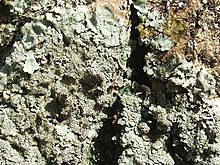Parmelia ernstiae
| Parmelia ernstiae | |
|---|---|

| |
| Scientific classification | |
| Domain: | Eukaryota |
| Kingdom: | Fungi |
| Division: | Ascomycota |
| Class: | Lecanoromycetes |
| Order: | Lecanorales |
| Family: | Parmeliaceae |
| Genus: | Parmelia |
| Species: | P. ernstiae
|
| Binomial name | |
| Parmelia ernstiae Feuerer & A.Thell (2002)
| |
Parmelia ernstiae is a species of foliose lichen in the family Parmeliaceae. It occurs in Europe.
Taxonomy[edit]
The lichen was described as a new species in 2002 by lichenologists Tassilo Feuerer and Arne Thell. The type specimen was collected from the trunk of European ash (Fraxinus excelsior) in Germany. It is a member of the Parmelia saxatilis species complex; it can be distinguished from that species by its strongly pruinose thallus and isidia.[1] Another member of this complex is Parmelia serrana.[2]
Distribution[edit]
First reported in Germany, Parmelia ernstiae has since been recorded Fennoscandia, including Denmark, southern Finland, and southwestern Sweden.[3] It was reported as new to Norway in 2019,[4] the same year it was reported from Belarus.[5] The eastern limits of its distribution extend to Bosnia-Herzegovina, the Czech Republic, and eastern Germany. Parmelia ernstiae typically grows on tree bark, although a single specimen from Denmark has been found growing on rock. Other than the substrate, it is morphologically and chemically identical to individuals that grow on bark.[2]
Description[edit]
The thallus of Parmelia ernstiae comprises small rounded lobes that rarely overlap each other. In the central parts of the thallus, the lobes are intermixed with isidia. The thallus has a pruinose coating, which helps to distinguish it from P. saxatilis. The lobes of the lookalike Parmelia serrana are larger than those of P. ernstiae, and typically overlap.[2]
Chemistry[edit]
Several secondary chemicals have been identified in Parmelia ernstiae, including: salazinic acid (a major compound), atranorin, chloroatranorin, consalazinic acid, lobaric acid, lichesterinic acid, protolichesterinic acid, nephrosterinic acid, and isonephrosterinic acid (all minor compounds). Parmelia ernstiae has the largest set of secondary chemicals in the Parmelia saxatilis group, and can be distinguished from those lookalikes by its secondary chemical composition.[2]
References[edit]
- ^ Feuerer, T.; Thell, A. (2002). "Parmelia ernstiae Feuerer & Thell – a new macrolichen from Germany". Mitteilungen aus dem Institut für Allgemeine Botanik Hamburg (in German). 30–32: 49–60.
- ^ a b c d Thell, Arne; Elix, John A.; Feuerer, Tassilo; Hansen, Eric Steen; Kärnefelt, Ingvar; Schüler, Nikolaus; Westberg, Martin (2008). "Notes on the systematics, chemistry and distribution of European Parmelia and Punctelia species (lichenized ascomycetes)" (PDF). Sauteria. 15: 545–559.
- ^ Thell, Arne; Tsurykau, Andrei; Persson, Per-Erik; Hansson, Mats (2017). "Parmelia ernstiae, P. serrana and P. submontana, three species increasing in the Nordic countries". Graphis Scripta. 29: 24–32.
- ^ Haugan, Reidar; Timdal, Einar (2019). "The morphologically cryptic lichen species Parmelia ernstiae and P. serrana new to Norway". Graphis Scripta. 31: 5–13.

- ^ Tsurykau, Andrei; Bely, Pavel; Golubkov, Vladimir; Persson, Per-Erik; Thell, Arne (2019). "The lichen genus Parmelia (Parmeliaceae, Ascomycota) in Belarus". Herzogia. 32 (2): 375–384. doi:10.13158/heia.32.2.2019.375. S2CID 209522900.
